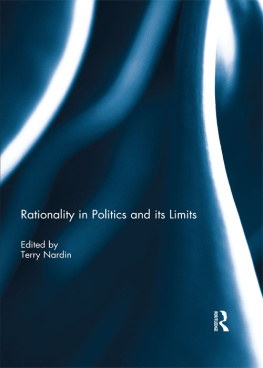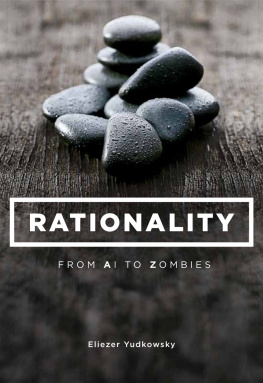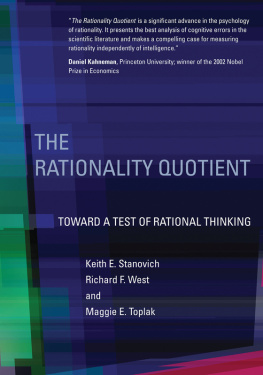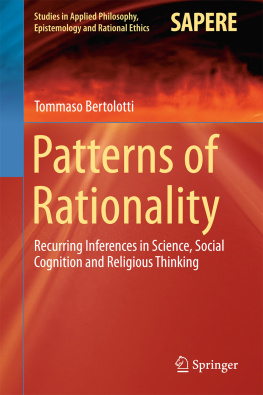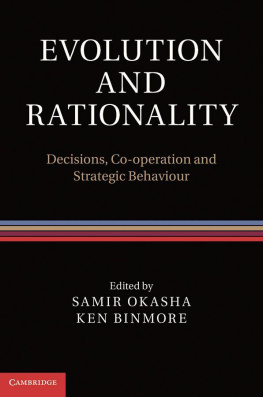Contents
Guide
Pagebreaks of the print version
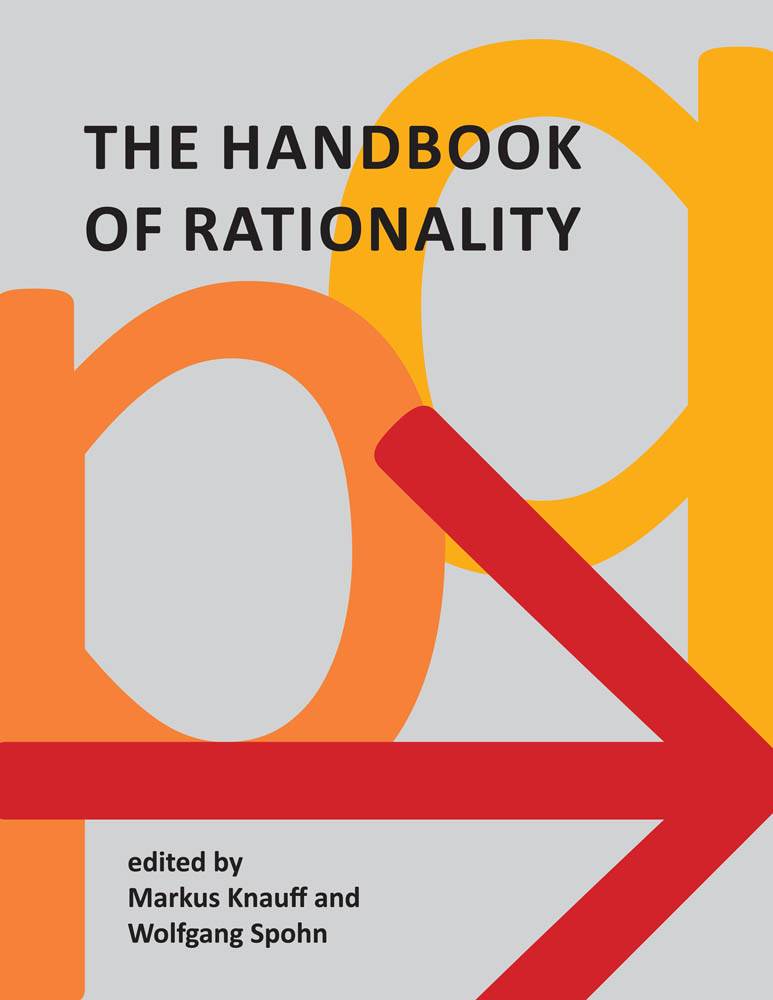
The Handbook of Rationality
Edited by Markus Knauff and Wolfgang Spohn
The MIT Press
Cambridge, Massachusetts
London, England
2021 The Massachusetts Institute of Technology
All rights reserved. No part of this book may be reproduced in any form by any electronic or mechanical means (including photocopying, recording, or information storage and retrieval) without permission in writing from the publisher.
The MIT Press would like to thank the anonymous peer reviewers who provided comments on drafts of this book. The generous work of academic experts is essential for establishing the authority and quality of our publications. We acknowledge with gratitude the contributions of these otherwise uncredited readers.
Library of Congress Cataloging-in-Publication Data
Names: Knauff, Markus, editor. | Spohn, Wolfgang, editor.
Title: The handbook of rationality / edited by Markus Knauff and Wolfgang Spohn.
Description: Cambridge : The MIT Press, 2021. | Includes bibliographical references and index.
Identifiers: LCCN 2020048455 | ISBN 9780262045070 (hardcover)
Subjects: LCSH: Reasoning (Psychology) | Reason. | Cognitive psychology. | Logic. | Philosophy of mind.
Classification: LCC BF442 .H36 2021 | DDC 153.4/3dc23
LC record available at https://lccn.loc.gov/2020048455
d_r0
Contents
- Markus Knauff and Wolfgang Spohn
- Markus Knauff and Wolfgang Spohn
- Thomas Sturm
- Jonathan St. B. T. Evans
- Gerhard Schurz
- Vinod Goel
- John Broome
- Ralph Wedgwood
- P. N. Johnson-Laird
- Klaus Fiedler, Johannes Prager, and Linda McCaughey
- Karl Christoph Klauer
- Johan van Benthem, Fenrong Liu, and Sonja Smets
- Florian Steinberger
- David P. OBrien
- Sangeet Khemlani
- Alan Hjek and Julia Staffel
- Stephan Hartmann
- Arthur Merin
- Niki Pfeifer
- Nick Chater and Mike Oaksford
- Klaus Oberauer and Danielle Pessach
- Didier Dubois and Henri Prade
- Hans van Ditmarsch
- Hans Rott
- Gabriele Kern-Isberner, Niels Skovgaard-Olsen, and Wolfgang Spohn
- Lupita Estefania Gazzo Castaeda and Markus Knauff
- Ulrike Hahn and Peter Collins
- John Woods
- William B. Starr
- David E. Over and Nicole Cruz
- Ruth M. J. Byrne and Orlando Espino
- Jean-Franois Bonnefon
- Judea Pearl
- Michael R. Waldmann
- Bjrn Meder and Ralf Mayrhofer
- Till Grne-Yanoff
- Martin Peterson
- Andreas Glckner
- Brian Hill
- Ralph Hertwig and Anastasia Kozyreva
- Valerie A. Thompson, Shira Elqayam, and Rakefet Ackerman
- Max Albert and Hartmut Kliemt
- Andrs Perea
- J. McKenzie Alexander
- Sanjit Dhami and Ali al-Nowaihi
- Franz Dietrich and Kai Spiekermann
- Hans Bernhard Schmid
- Georg Meggle
- Werner Raub
- Julian Nida-Rmelin, Rebecca Gutwald, and Niina Zuber
- Leda Cosmides and John Tooby
- John Horty and Olivier Roy
- Shira Elqayam
- Eric Hilgendorf
- Henry Prakken
- Christoph Fehige and Ulla Wessels
- Michael Smith
- Alex Wiegmann and Hanno Sauer
- Mateja Jamnik
- Marco Ragni
- Markus Knauff
- Line Edslev Andersen and Hanne Andersen
- Anke Bueter
- Rainer Bromme and Lukas Gierth
- Henry Markovits
- Keith E. Stanovich, Maggie E. Toplak, and Richard F. West
- Stephanie de Oliveira and Richard Nisbett
List of Figures
MuellerLyer illusion.
Evolution-based structure of human cognition.
Systems for inference generation and conflict detection. (ah) Systems for inference generation: (a) A left dorsolateral prefrontal cortex (PFC) system is involved in generating inductive inferences (reproduced with permission from Goel & Dolan, 2004); (b) a left lateral frontal-temporal linguistic system is activated during syllogistic reasoning involving content that we have beliefs about (reproduced with permission from Goel, Buchel, Frith, & Dolan, 2000); (c, d) bilateral frontal and parietal spatial systems are involved in formal syllogistic reasoning lacking meaningful semantic content (reproduced with permission from Goel et al., 2000); (e) linguistic transitive arguments with conclusions that we have beliefs about engage the left parahippocampal gyrus and the bilateral hippocampus (reproduced with permission from Goel, Makale, & Grafman, 2004); (f) linguistic transitive arguments involving conclusions that we have no beliefs about engage spatial systems in the bilateral parietal cortex (reproduced with permission from Goel, Makale, et al., 2004); (g) transitive arguments with pictorial stimuli engage the right rostral lateral PFC (reproduced with permission from Wendelken & Bunge, 2010); (h) indeterminate arguments with content that we have no beliefs about engage the right ventral lateral PFC (reproduced with permission from Goel, Stollstorff, Nakic, Knutson, & Grafman, 2009). (i) A common system for conflict detection: a common right lateral/dorsolateral PFC (BA 44/45) system seems to be engaged in detecting and/or resolving conflict or inconsistency (reproduced with permission from Goel & Dolan, 2003).
Brunswiks (1955) lens model applied to subjective judgments of danger, mediated by five proximal cues framed to resemble some of the most well-known heuristics (recognition, availability, simulation heuristic). Statistical relations of proximal cues to distal entities are called ecological validities. The weights given to cues in subjective judgments are referred to as cue utilization.
Three tasks frequently used in research on dual-process models.
An extensive game.
A social influence network.
The percentages of responses to 64 syllogisms in the meta-analysis in Khemlani and Johnson-Laird (2012). Each of the 64 pairs of premises occurs in a row, and each of the possible responses occurs in a column. Abbreviations for premises are as follows: Aac = All of the A are C, Iac = Some of the A are C, Eac = None of the A is a C, Oac = Some of the A are not C, and NVC = No valid conclusion. The left panel denotes the 27 syllogisms with a valid definite conclusion, and the right panel denotes the 37 syllogisms without a valid definite conclusion. The grayscale in each cell indicates the proportion of corresponding conclusions (black = 100% and white = 16% or below). Hence, for the top-most valid syllogism, Aab Abc, nearly 100% of participants in the meta-analysis responded that Aac follows.
A schematic diagram of how Hattoris (2016) probability sampling model draws syllogistic conclusions. (Used with permission from Hattori, 2016.)
A schematic diagram of the program implemented in mReasoner for reasoning with mental models of quantified assertions such as All the designers are women. White boxes denote procedures, gray boxes denote parameters, and the black box denotes the point at which the program generates a conclusion. The program integrates two separate reasoning pipelines: a fast, heuristic process (represented by solid arrows) that does not revise models and a slow, recursive, deliberative process (represented by dotted arrows) that revises initial models and draws conclusions from the set of alternative models. The diagram also highlights the stochastic algorithm that controls how models are built.


